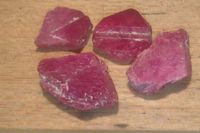Difference between revisions of "Aluminium oxide"
| Line 116: | Line 116: | ||
===Physical=== | ===Physical=== | ||
| − | Aluminium oxide is very hard | + | Aluminium oxide is a white solid compound, insoluble in water and solvent, but will dissolve in non-oxidizing acids. It is odorless and it's very hard (9 Mohs scale). It's an electrical insulator. |
| − | It's electrical insulator. | + | |
==Availability== | ==Availability== | ||
| − | Aluminium oxide is often present in sandpapers, you can also buy it from mineral collectors as corrundum or gemstones like ruby or | + | Aluminium oxide is often present in sandpapers, you can also buy it from mineral collectors as corrundum or gemstones like ruby or sapphire. |
Heating elements also contain alumina powder which acts as an insulator for the resistance wiring. | Heating elements also contain alumina powder which acts as an insulator for the resistance wiring. | ||
| Line 126: | Line 125: | ||
==Preparation== | ==Preparation== | ||
Aluminium oxide is a product of [[thermite]] reaction: | Aluminium oxide is a product of [[thermite]] reaction: | ||
| + | |||
:M<sub>2</sub>O<sub>3</sub> + 2 Al → Al<sub>2</sub>O<sub>3</sub> + 2 M | :M<sub>2</sub>O<sub>3</sub> + 2 Al → Al<sub>2</sub>O<sub>3</sub> + 2 M | ||
| Line 136: | Line 136: | ||
==Handling== | ==Handling== | ||
| − | |||
===Safety=== | ===Safety=== | ||
| − | + | No special handling is necessary, though it's recommonded to avoid inhaling in in powdered form. Aluminium oxide isn't flamable or explosive. | |
| − | Aluminium oxide isn't flamable or explosive. | + | |
===Storage=== | ===Storage=== | ||
Revision as of 18:06, 4 August 2017
 Samples of ruby, a red variant of corundum.
| |
| Names | |
|---|---|
| IUPAC name
Aluminium(III) oxide
| |
| Systematic IUPAC name
Aluminium oxide | |
| Other names
Aloxide
Aloxite Alumina Alundum Corundum Ruby Saphire | |
| Identifiers | |
| Jmol-3D images | Image |
| |
| Properties | |
| Al2O3 | |
| Molar mass | 101.96 g/mol |
| Appearance | White solid |
| Odor | Odorless |
| Density | 3.95–4.1 g/cm3 |
| Melting point | 2,072 °C (3,762 °F; 2,345 K) |
| Boiling point | 2,977 °C (5,391 °F; 3,250 K) |
| Insoluble | |
| Solubility | Reacts with halogenic acids and alkali Insoluble in organic solvents |
| Vapor pressure | ~0 mmHg |
| Thermochemistry | |
| Std molar
entropy (S |
50.92 J·mol−1·K−1 |
| Std enthalpy of
formation (ΔfH |
−1675.7 kJ/mol |
| Hazards | |
| Safety data sheet | Sigma-Aldrich |
| Flash point | Non-flammable |
| Related compounds | |
| Related compounds
|
Boron trioxide |
| Except where otherwise noted, data are given for materials in their standard state (at 25 °C [77 °F], 100 kPa). | |
| Infobox references | |
Aluminium oxide or alumina is the chemical compound of aluminum and oxygen, with chemical formula Al2O3. It's the most common and stable form of the aluminium oxides. Aluminium oxide occurs naturally in it's crystalline alpha phase as mineral corundum.
Contents
Properties
Chemical
Aluminium oxide will react with sodium hydroxide to form sodium aluminate.
Physical
Aluminium oxide is a white solid compound, insoluble in water and solvent, but will dissolve in non-oxidizing acids. It is odorless and it's very hard (9 Mohs scale). It's an electrical insulator.
Availability
Aluminium oxide is often present in sandpapers, you can also buy it from mineral collectors as corrundum or gemstones like ruby or sapphire.
Heating elements also contain alumina powder which acts as an insulator for the resistance wiring.
Preparation
Aluminium oxide is a product of thermite reaction:
- M2O3 + 2 Al → Al2O3 + 2 M
This reaction also gives various aluminates, and separating the alumina from the slag is complicated and may not worth it.
A much better method involves the dehydration of aluminium hydroxide
Projects
- Make aluminium salts
Handling
Safety
No special handling is necessary, though it's recommonded to avoid inhaling in in powdered form. Aluminium oxide isn't flamable or explosive.
Storage
Storage in closed bottles is adequate.
Disposal
Aluminium oxide could be safely dumped with normal trash or spilled out in a soil.
References
Relevant Sciencemadness threads
- Chemical pages without CAS Registry Number
- Articles without EBI source
- Chemical pages without ChemSpiderID
- Chemical pages without DrugBank identifier
- Articles without KEGG source
- Articles without InChI source
- Articles without UNII source
- Articles containing unverified chemical infoboxes
- Chemical compounds
- Inorganic compounds
- Aluminium compounds
- Oxides
- Materials unstable in acidic solution
- Materials unstable in basic solution
- Solids
- Minerals